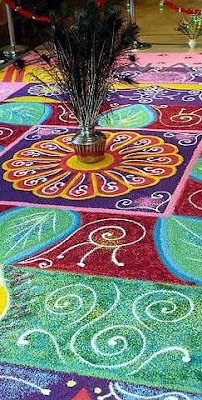Whenever Deepavali comes around the corner, you can see many PJ and KL shopping malls and offices with decoration of Kolam on the floor. If you wondered what it all meant, the article below would give you some insights about the tradition of Kolam and what it symbolizes.
Kolam an artform to symbolise happiness
By Vijenthi Nair
Photos By Low Lay Phon
24/October/2011
KOLAM is much more than just an aesthetic art and symbolises happiness and prosperity, according to Indian beliefs.
The dotted kolam that is made from rice flour is drawn at the entrance of the house to feed insects and birds.
It represents man’s concern for all living creatures.
The kolam and the bright red border enclosing it, is also believed to prevent evil spirits from entering the house.
Kolam artist Mohan Maruthamuthu said Ranggoli (coloured) kolam was the evolved version of the dotted kolam.
However, in recent times the Ranggoli kolam have seen an evolution with many shopping malls and corporations drawing the artform in their premises.
Over the years, people added colours to the dotted kolam to make it more attractive.
“All of my work so far are for Ranggoli Kolam.
“The bright colours fused with creative designs is more appealing to many and also involves a lot more work compared with the original one. Usually dyed crushed rice are used to create beautiful Indian designs and symbols.
“However, the beauty of the white flour is in a class of its own. Kolam should be drawn at the entrance so it would not be missed by visitors. In India, kolam is drawn every day by the women in the morning to invite ants to feed on it, thus receiving its blessings in return.
Mohan said kolam design was up to one’s creativity although there were now many kolam guide books to help beginners, especially with the dotted kolam.
“The parallel dots need to be calculated and arranged in order to get the straight and curves right. For dotted kolam, all the dots are drawn first, followed by the curved lines around the dots connecting each other. The thumb and forefingers are used to control the flow of flour.
“It is easy once you get the feel and flow of it. There is no end to the design as you can add on as you like or just run a finger through the lines to get an added effect,” he said.
Mohan feels that tradition can evolve but must not deviate from its main purpose.
“The tradition should be kept alive. The youths expressing their support for the football teams through kolam adds no value or meaning to it. It is best to keep it traditional and create innovative designs to further enhance the age-old art,” he added. -- Star Metro








0 comments:
Post a Comment